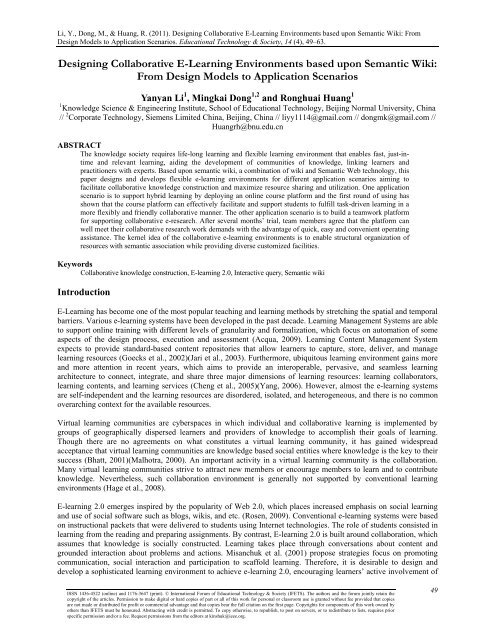October 2011 Volume 14 Number 4 - Educational Technology ...
October 2011 Volume 14 Number 4 - Educational Technology ...
October 2011 Volume 14 Number 4 - Educational Technology ...
You also want an ePaper? Increase the reach of your titles
YUMPU automatically turns print PDFs into web optimized ePapers that Google loves.
Li, Y., Dong, M., & Huang, R. (<strong>2011</strong>). Designing Collaborative E-Learning Environments based upon Semantic Wiki: From<br />
Design Models to Application Scenarios. <strong>Educational</strong> <strong>Technology</strong> & Society, <strong>14</strong> (4), 49–63.<br />
Designing Collaborative E-Learning Environments based upon Semantic Wiki:<br />
From Design Models to Application Scenarios<br />
Yanyan Li 1 , Mingkai Dong 1,2 and Ronghuai Huang 1<br />
1 Knowledge Science & Engineering Institute, School of <strong>Educational</strong> <strong>Technology</strong>, Beijing Normal University, China<br />
// 2 Corporate <strong>Technology</strong>, Siemens Limited China, Beijing, China // liyy11<strong>14</strong>@gmail.com // dongmk@gmail.com //<br />
Huangrh@bnu.edu.cn<br />
ABSTRACT<br />
The knowledge society requires life-long learning and flexible learning environment that enables fast, just-intime<br />
and relevant learning, aiding the development of communities of knowledge, linking learners and<br />
practitioners with experts. Based upon semantic wiki, a combination of wiki and Semantic Web technology, this<br />
paper designs and develops flexible e-learning environments for different application scenarios aiming to<br />
facilitate collaborative knowledge construction and maximize resource sharing and utilization. One application<br />
scenario is to support hybrid learning by deploying an online course platform and the first round of using has<br />
shown that the course platform can effectively facilitate and support students to fulfill task-driven learning in a<br />
more flexibly and friendly collaborative manner. The other application scenario is to build a teamwork platform<br />
for supporting collaborative e-research. After several months’ trial, team members agree that the platform can<br />
well meet their collaborative research work demands with the advantage of quick, easy and convenient operating<br />
assistance. The kernel idea of the collaborative e-learning environments is to enable structural organization of<br />
resources with semantic association while providing diverse customized facilities.<br />
Keywords<br />
Collaborative knowledge construction, E-learning 2.0, Interactive query, Semantic wiki<br />
Introduction<br />
E-Learning has become one of the most popular teaching and learning methods by stretching the spatial and temporal<br />
barriers. Various e-learning systems have been developed in the past decade. Learning Management Systems are able<br />
to support online training with different levels of granularity and formalization, which focus on automation of some<br />
aspects of the design process, execution and assessment (Acqua, 2009). Learning Content Management System<br />
expects to provide standard-based content repositories that allow learners to capture, store, deliver, and manage<br />
learning resources (Goecks et al., 2002)(Jari et al., 2003). Furthermore, ubiquitous learning environment gains more<br />
and more attention in recent years, which aims to provide an interoperable, pervasive, and seamless learning<br />
architecture to connect, integrate, and share three major dimensions of learning resources: learning collaborators,<br />
learning contents, and learning services (Cheng et al., 2005)(Yang, 2006). However, almost the e-learning systems<br />
are self-independent and the learning resources are disordered, isolated, and heterogeneous, and there is no common<br />
overarching context for the available resources.<br />
Virtual learning communities are cyberspaces in which individual and collaborative learning is implemented by<br />
groups of geographically dispersed learners and providers of knowledge to accomplish their goals of learning.<br />
Though there are no agreements on what constitutes a virtual learning community, it has gained widespread<br />
acceptance that virtual learning communities are knowledge based social entities where knowledge is the key to their<br />
success (Bhatt, 2001)(Malhotra, 2000). An important activity in a virtual learning community is the collaboration.<br />
Many virtual learning communities strive to attract new members or encourage members to learn and to contribute<br />
knowledge. Nevertheless, such collaboration environment is generally not supported by conventional learning<br />
environments (Hage et al., 2008).<br />
E-learning 2.0 emerges inspired by the popularity of Web 2.0, which places increased emphasis on social learning<br />
and use of social software such as blogs, wikis, and etc. (Rosen, 2009). Conventional e-learning systems were based<br />
on instructional packets that were delivered to students using Internet technologies. The role of students consisted in<br />
learning from the reading and preparing assignments. By contrast, E-learning 2.0 is built around collaboration, which<br />
assumes that knowledge is socially constructed. Learning takes place through conversations about content and<br />
grounded interaction about problems and actions. Misanchuk et al. (2001) propose strategies focus on promoting<br />
communication, social interaction and participation to scaffold learning. Therefore, it is desirable to design and<br />
develop a sophisticated learning environment to achieve e-learning 2.0, encouraging learners’ active involvement of<br />
ISSN <strong>14</strong>36-4522 (online) and 1176-3647 (print). © International Forum of <strong>Educational</strong> <strong>Technology</strong> & Society (IFETS). The authors and the forum jointly retain the<br />
copyright of the articles. Permission to make digital or hard copies of part or all of this work for personal or classroom use is granted without fee provided that copies<br />
are not made or distributed for profit or commercial advantage and that copies bear the full citation on the first page. Copyrights for components of this work owned by<br />
others than IFETS must be honoured. Abstracting with credit is permitted. To copy otherwise, to republish, to post on servers, or to redistribute to lists, requires prior<br />
specific permission and/or a fee. Request permissions from the editors at kinshuk@ieee.org.<br />
49

















